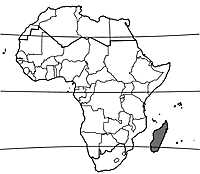Baroniella acuminata (PROTA)
Introduction |
| General importance | |
| Geographic coverage Africa | |
| Geographic coverage World | |
| Medicinal | |
| Conservation status | |
Baroniella acuminata (Choux) Bullock
- Protologue: Kew Bull. 10: 283 (1955).
- Family: Asclepiadaceae (APG: Apocynaceae)
Synonyms
- Baseonema acuminatum Choux (1913).
Origin and geographic distribution
Baroniella acuminata is endemic to eastern Madagascar.
Uses
In traditional medicine a decoction of the aerial parts or of the leaves is taken to treat cough, coughing fits as well as asthma attacks in children.
Properties
Phytochemical analyses of the aerial parts revealed the presence of sugars, the triterpene ursolic acid, various sterols e.g. sitosterol, the pregnane glycosides baseonemoside A, B and C and several polyphenol glycosides.
An aqueous extract of the aerial parts inhibited the anaphylaxis-induced broncho-constriction in vitro and in vivo in guinea-pigs. The contracting effect induced by the immunological reaction on the guinea-pig isolated trachea was prevented by the triterpenes isolated from the plant. Several of the phenolic compounds showed significant activity against the growth of different Candida albicans strains in vitro, but no antibacterial activity against 6 bacteria in vitro.
A clinical test in 1984 with 43 adults taking a syrup made from the leaves showed good tolerance of the syrup but mixed efficacy.
Description
Slender, glabrous liana up to 6 m long; latex white. Leaves opposite, simple and entire; stipules absent; petiole 1–3 mm long; blade ovate to elliptical, 2–3 cm × 1–2 cm, base rounded, apex acuminate, veins raised above. Inflorescence a terminal, few-flowered cyme up to 5 cm long; bracts up to 1.5 mm long, persistent. Flowers bisexual, regular, 5-merous, violet; pedicel 3–7(–20) mm long; calyx lobes ovate, c. 0.5 mm long; corolla with tube c. 0.7 mm long, lobes broadly elliptical, c. 2.7 mm × 2.2 mm, apex rounded to acute; corona a short ring at base, interstaminal lobes largest, c. 0.2 mm long; stamens inserted at corolla mouth, free, filaments c. 0.4 mm long, wit prolongation of connective as long as thecae, flattened, leaning on style head, pollen carriers c. 0.3 mm long, on small knobs; style including head c. 0.8 mm long, head discoid, with 5 lobes. Fruit a pair of follicles, green, up to 12 cm long.
Other botanical information
Baroniella comprises 7 species, which are all endemic to Madagascar. It is considered to be most closely related to Camptocarpus, which is distributed in Madagascar and the Mascarene islands. Baroniella has long been included in Baseonema, but is now considered to be separate. The continental African Baseonema gregorii Schltr. & Rendle remains the only species in the monotypic genus Baseonema. Baroniella belongs to the subfamily Periplocoideae.
Ecology
Baroniella acuminata occurs in the transition zone between the eastern rain forest and the plateau, and also in shrub vegetation at the southern part of the plateau, at 800–1500 m altitude. It flowers from November to February.
Genetic resources
Baroniella acuminata is only known from a few localities and apparently is locally abundant. It is not known whether it is threatened by genetic erosion.
Prospects
Phytochemical and pharmacological analyses showed interesting activities of Baroniella acuminata against Candida albicans and to suppress cough, and further research seems warranted.
Major references
- Andriamahery, M., 1994. Aperçu sur l’utilisation des plantes médicinales par la communauté rurale de la région d’Andasibe. Thèse pour l'obtention du grade de Docteur en médecine, Etablissement d'Enseignement Supérieur des Sciences de la Santé, Faculté de Médecine Université d'Antananarivo, Madagascar. 74 pp.
- De Leo, M., Braca, A., De Tommasi, N., Norscia, I., Morelli, I., Battinelli, L. & Mazzanti, G., 2004. Phenolic compounds from Baseonema acuminatum leaves: isolation and antimicrobial activity. Planta Medica 70: 841–846.
- Klackenberg, J., 1997. Revision of the genus Baroniella Constatin & Gallaud (Asclepiadaceae, Periplocaceae). Candollea 52(2): 383–407.
Other references
- Andriantsiferana, R., Rajaomaria, M. & Randriantsoa, A., 1983. Contribution à l’étude de l’action antitussive de Baseonema sp. Archives du CNARP 2: 133–140.
- Andriantsoa, M. & Andriatsiferana, R., 1983. Mise en évidence d’une éventuelle propriété antibactérienne chez quelques extraits de plantes utilisées à Madagascar pour lutter contre les manifestations diarrhéiques. Archives du CNARP 2: 179–182.
- Rasamison, V.E., 2000. Contribution à l’étude chimique de Baseonema acuminatum P. Choux. (Asclépiadacées): mise en évidence de nouveaux glycostéroïdes. Thèse de Doctorat de 3ième Cycle en Chimie organique, Option Produits naturels, Faculté des Sciences, Université d’Antananarivo, Madagascar. 105 pp.
- Rasamison, V.E., Cutrone, J.Q. & Okunade, A.L., 2002. Additional pregnane glycoside from Baseonema acuminatum. Fitoterapia 73: 442–444.
- Rasamison, V.E., Okunade, A.L., Ratsimbason, A.M. & Rafidinarivo, E., 2001. Pregnane glycosides from Baseonema acuminatum. Fitoterapia 72: 5–11.
- Ratsimbason, A.M., Rasamison, V.E., Razafindrabeaza, T. & Rahelinirina, L., 1997-1998. Test anti-anaphylactique des extraits d’une Asclepiadacée: Baseonema acuminatum. Revue de médecines et pharmacopées africaines 11-12: 143–150
Author(s)
- G.H. Schmelzer, PROTA Network Office Europe, Wageningen University, P.O. Box 341, 6700 AH Wageningen, Netherlands
Correct citation of this article
Schmelzer, G.H., 2010. Baroniella acuminata (Choux) Bullock. In: Schmelzer, G.H. & Gurib-Fakim, A. (Editors). PROTA (Plant Resources of Tropical Africa / Ressources végétales de l’Afrique tropicale), Wageningen, Netherlands. Accessed 6 March 2025.
- See the Prota4U database.

